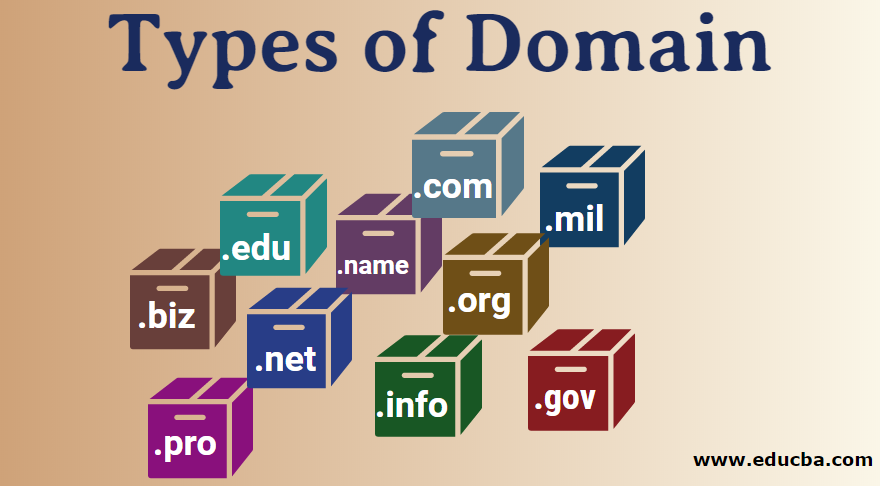
Introduction to Types of Domain
Domains are categorized into three parts generic domains, country domains and inverse domains, where generic domains define registered hosts according to their generic behaviour, country domains use two characters country abbreviation, inverse domain maps address to map. Some of the generic domains are com (commercial organization), Edu (educational institutions), gov (government institutions), org (a non-profit organization), biz (businesses firm), etc. Country domains are us(United States), in (India), etc. Inverse domain are like 121.45.34.132.in -addr.arpa.
What is Domain?
Let’s begin with what the domain name of the website is. The domain name’s essence is the first tap in the URL or the web address between the protocol symbol (HTTP:/). The domain name would thus be dominain.com for the URL: https:/www.domain.com / hosting/. You may not notice or view today that this domain constitutes the IP address of the desktop or website. A registered domain name is unique to you and can not be used for anyone since it works like a street address in the physical world on the website.
Types of Domain Name
Below are the different domain types, which are as follows.
1) Top-Level Domain
- .net
- .edu
- .org
- .com
- .mil
- .gov
Description of each of the Domain Name is given below
a) .net
Network shorthand was developed specifically for institutions participating in-network systems such as a web service provider or an infrastructure firm. As with .com, the restrictions were never upheld to limit.net to networking purposes, and it was one of the most popular top-class fields, and many saw it as close to the top-class domain.com.
b) .edu
.edu was produced for educational organizations by shorthand for education. While the TLD.edu was designed for universities worldwide, only instructional centres in America were linked to it. Schools in other nations use .edu together with their national domain, which is discussed in the next chapter below.
c) .org
.org was developed for Nonprofits, shorthand for the organization. As we saw with the other domains at the top, these intentions were often not maintained or implemented over time. Today, the company’s non-profits, profit enterprises, schools, and communities are used as high-level domain.
d) .com
The first high-level domain in popular use was for business shorthand, .com. Whilst .com was originally developed for use by businesses, this was not restricted strictly. .com was the most common type of high-level domain for companies, websites, and emails by the mid-1990s.
e) .mil
Military shorthand,.mil was specifically developed for the US military. This limitation is still maintained as opposed to other top-level domain kinds. In combination with the .mil TLD, it is common for .mil to use second and third-level domains.
f) .gov
Shorthand was restricted for the government, like .mil to federal government agencies only and only staff use. Today,.gov has been used in the town, cities, area, cities, counties and Native American tribes by government agencies.
2) Generic Top-Level Domain (GTLD)
Generic top-level domains work as a top-level domain category in the DNS. At present, there are 21 top-level generic domains within the root zone, the best level of the structure of the domain name scheme. Although over 1,500 gTLDs are used, the majority of these 21 constitute domain names of all types.
Four subcategories are included:
1. (.com, .info, .net, .org ) Domains that are generally applicable.
2. ( .pro, .biz, .name) This domain is generally used for specific reason or purpose.
3) Second Level Domain
Domains of the second level are domains that follow top levels within the DNS hierarchy. Nike is the second-class domain of the top.com domain, for instance, in Nike.com. The name of a company or seller that registered a domain name with a registrar is often the second-level domain. For prospective clients, the brand name, business name or project name is the identifier.
4) Third Level Domain
Domains in the third stage are obviously secondary domains within the DNS hierarchy. It is to the left of the SLD and is often known as the subdomain. Larger enterprises often use third-level areas as identifiers to differentiate between different departments. “www” is the most frequent third-level domain in general.
DNS (Domain Name System)
The Domain Name System works by transforming the domain name into a server of IP addresses. It is located on millions of servers worldwide but serves as one unified database. Next, when you insert your search browser’s domain name with the Best Domain Registrars. The browser is contacted by a name server to locate the matched IP address. If you did not request a name for a domain previously, that request passes through a server sorted by the domain name system’s hierarchy, beginning with top-level extensions and moving down the line.
Recommended Articles
This is a guide to Types of Domain. Here we have discussed the basic concept with different types of a domain: top-level Domain, second-level, and third-level domain, in detail. You may also have a look at the following articles to learn more –

